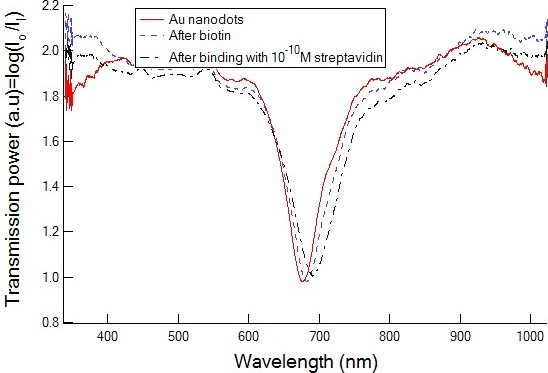E-Beam Patterned Gold Nanodot Arrays on Optical Fiber Tips for Localized Surface Plasmon Resonance Biochemical Sensing
Abstract
:1. Introduction
2. Experimental Methods
2.1. Device Fabrication
2.2. Measurement Setup
2.3. Materials
3. Results and Discussion
3.1. Bulk Refractive Index Change Characterizations
3.2. Biotin/Streptavidin for Affinity Sensing Characterizations
3.3. Numerical Simulation
4. Conclusions
Acknowledgments
References
- Mock, J; Smith, DR; Schultz, S. Local refractive index dependence of plasmon resonance spectra from individual nanoparticles. Nano Lett 2003, 3, 485–491. [Google Scholar]
- Eah, S; Jaeger, H; Scherer, N; Wiederrecht, G; Lin, X. Plasmon scattering from a single gold nanoparticle collected through an optical fiber. Appl. Phys. Lett 2005, 86, 031902. [Google Scholar]
- Fu, J; Park, B; Zhao, Y. Limitation of a localized surface plasmon resonance sensor for Salmonella detection. Sens. Actuat. B: Chem 2009, 141, 276–283. [Google Scholar]
- Yamamichi, J; Iida, M; Ojima, T; Handa, Y; Yamada, T; Kuroda, R; Imamura, T; Yano, T. The mesoscopic effect on label-free biosensors based on localized surface plasmon resonance of immobilized colloidal gold. Sens. Actuat. B: Chem 2009, 143, 349–356. [Google Scholar]
- Haynes, C; Van Duyne, R. Nanosphere lithography: A versatile nanofabrication tool for studies of size-dependent nanoparticle optics. J. Phys. Chem. B 2001, 105, 5599–5611. [Google Scholar]
- Sung, J; Hicks, E; Van Duyne, R; Spears, K. Nanoparticle spectroscopy: Dipole coupling in two-dimensional arrays of L-shaped silver nanoparticles. J. Phys. Chem. C 2007, 111, 10368–10376. [Google Scholar]
- Storhoff, J; Elghanian, R; Mucic, R; Mirkin, C; Letsinger, R. One-pot colorimetric differentiation of polynucleotides with single base imperfections using gold nanoparticle probes. J. Am. Chem. Soc 1998, 120, 1959–1964. [Google Scholar]
- Dhawan, A; Gerhold, M; Muth, J. Plasmonic structures based on subwavelength apertures for chemical and biological sensing applications. Sens. J. IEEE 2008, 8, 942–950. [Google Scholar]
- Dhawan, A; Muth, J; Leonard, D; Gerhold, M; Gleeson, J; Vo-Dinh, T; Russell, P. Focused ion beam fabrication of metallic nanostructures on end faces of optical fibers for chemical sensing applications. J Vac Sci Technol B 2008, 26. [Google Scholar] [CrossRef]
- Prikulis, J; Hanarp, P; Olofsson, L; Sutherland, D; Käll, M. Optical spectroscopy of nanometric holes in thin gold films. Nano Lett 2004, 4, 1003–1007. [Google Scholar]
- Gao, D; Chen, W; Mulchandani, A; Schultz, J. Detection of tumor markers based on extinction spectra of visible light passing through gold nanoholes. Appl. Phys. Lett 2007, 90, 073901–073903. [Google Scholar]
- Dahlin, A; Zäch, M; Rindzevicius, T; Käll, M; Sutherland, D; Höök, F. Localized surface plasmon resonance sensing of lipid-membrane-mediated biorecognition events. J. Amer. Chem. Soci 2005, 127, 5043–5048. [Google Scholar]
- Chang, Y; Chen, Y; Kuo, H; Wei, P. Nanofiber optic sensor based on the excitation of surface plasmon wave near fiber tip. J. Biomed. Opt 2006, 11, 014032. [Google Scholar]
- Mitsui, K; Handa, Y; Kajikawa, K. Optical fiber affinity biosensor based on localized surface plasmon resonance. Appl. Phys. Lett 2004, 85, 4231. [Google Scholar]
- Gu, C; Zhang, Y; Schwartzberg, A; Zhang, J. Ultra-sensitive compact fiber sensor based on nanoparticle surface enhanced Raman scattering. Proc. SPIE 2005, 08, 5911. [Google Scholar]
- White, D; Stoddart, P. Nanostructured optical fiber with surface-enhanced Raman scattering functionality. Opt. Lett 2005, 30, 598–600. [Google Scholar]
- Viheriala, J; Niemi, T; Kontio, J; Rytkonen, T; Pessa, M. Fabrication of surface reliefs on facets of singlemode optical fibres using nanoimprint lithography. Electron. Lett 2007, 43, 150–151. [Google Scholar]
- Smythe, E; Dickey, M; Bao, J; Whitesides, G; Capasso, F. Optical antenna arrays on a fiber facet for in situ surface-enhanced Raman scattering detection. Nano Lett 2009, 9, 1132–1138. [Google Scholar]
- Fu, Y; Bryan, N. Investigation of physical properties of quartz after focused ion beam bombardment. Appl. Phys. B 2005, 80, 581–585. [Google Scholar]
- Lin, Y; Guo, J; Lindquist, R. Demonstration of an ultra-wideband optical fiber inline polarizer with metal nano-grid on the fiber tip. Opt. Express 2009, 17, 17849–17854. [Google Scholar]
- Barbillon, G; Bijeon, J; Plain, J; de la Chapelle, M; Adam, P; Royer, P. Biological and chemical gold nanosensors based on localized surface plasmon resonance. Gold Bull 2007, 40, 240–244. [Google Scholar]
- Yeri, A; Gao, L; Gao, D. Mutation screening based on the mechanical properties of DNA molecules tethered to a solid surface. J. Phys. Chem. B 2010, 114, 1064–1068. [Google Scholar]
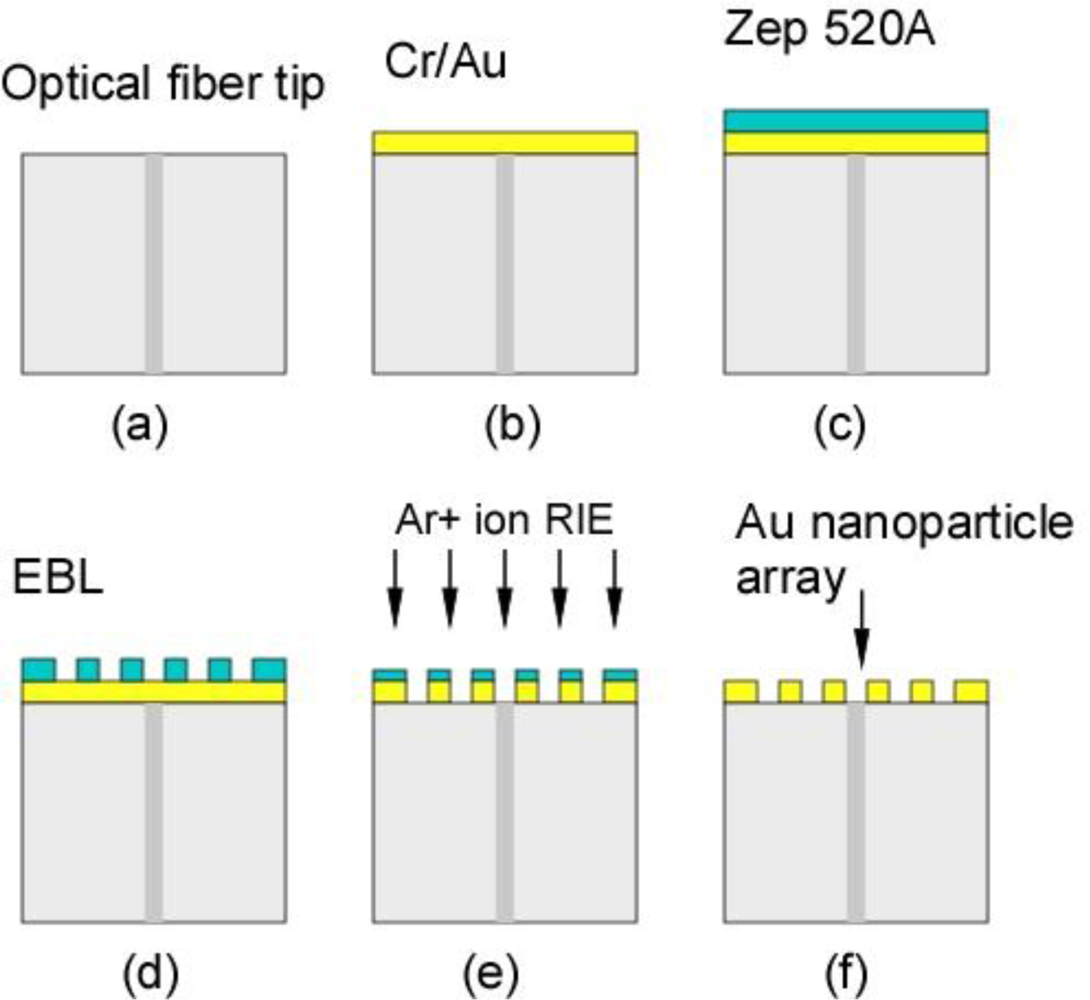
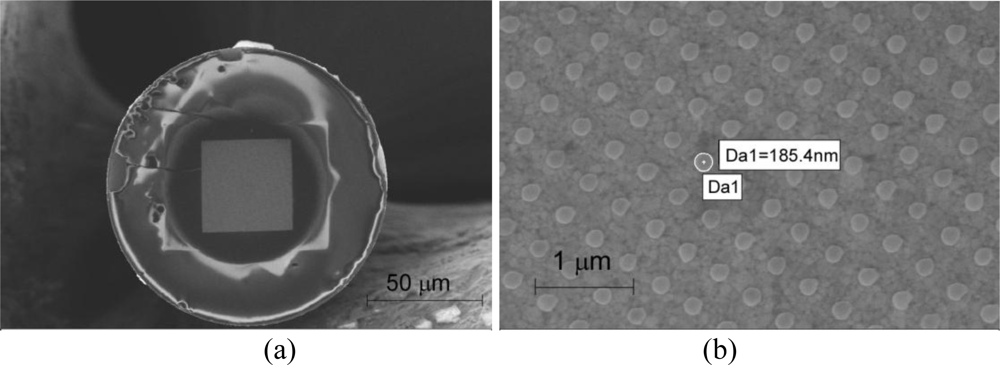

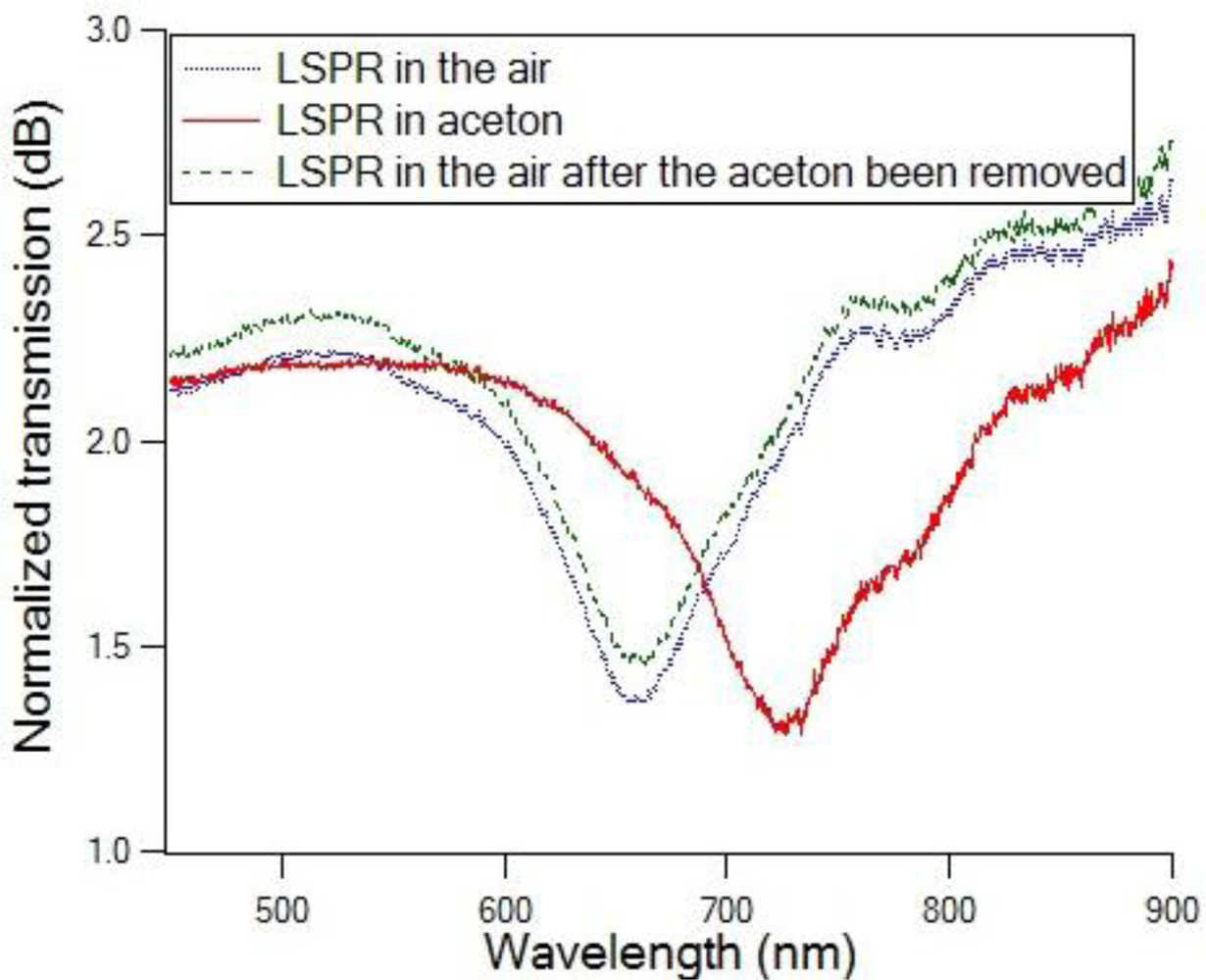
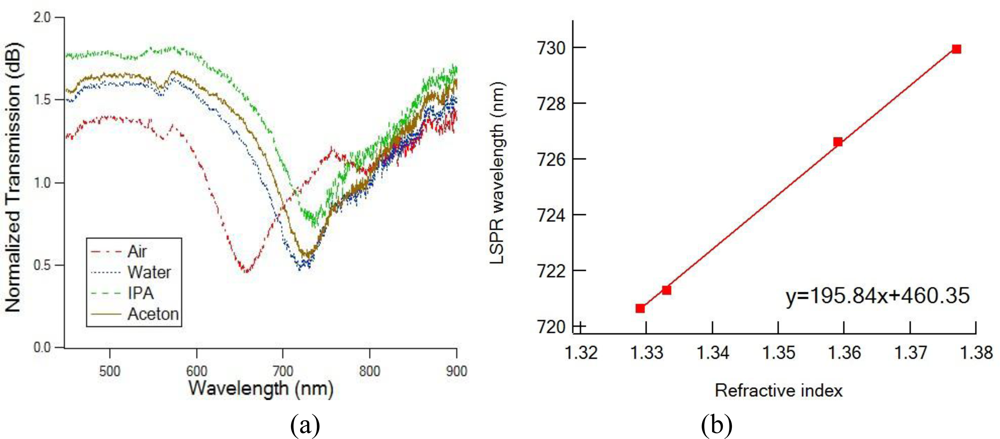

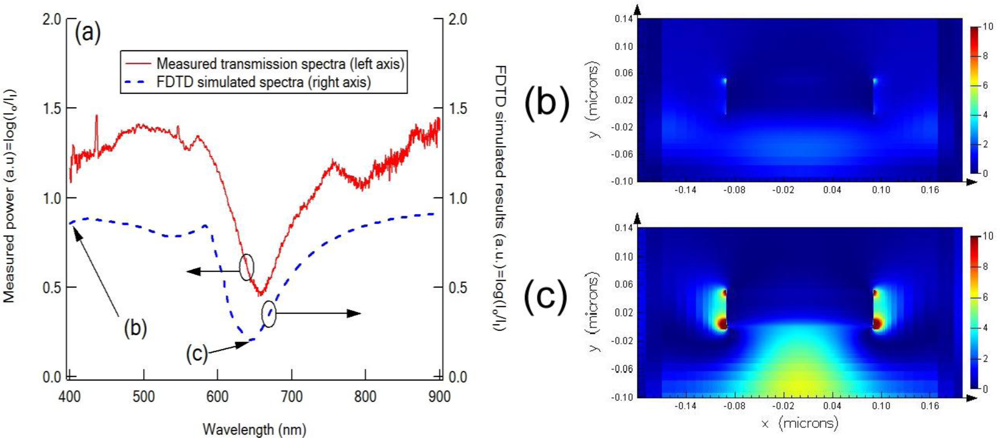
© 2010 by the authors; licensee MDPI, Basel, Switzerland. This article is an open access article distributed under the terms and conditions of the Creative Commons Attribution license (http://creativecommons.org/licenses/by/3.0/).
Share and Cite
Lin, Y.; Zou, Y.; Mo, Y.; Guo, J.; Lindquist, R.G. E-Beam Patterned Gold Nanodot Arrays on Optical Fiber Tips for Localized Surface Plasmon Resonance Biochemical Sensing. Sensors 2010, 10, 9397-9406. https://doi.org/10.3390/s101009397
Lin Y, Zou Y, Mo Y, Guo J, Lindquist RG. E-Beam Patterned Gold Nanodot Arrays on Optical Fiber Tips for Localized Surface Plasmon Resonance Biochemical Sensing. Sensors. 2010; 10(10):9397-9406. https://doi.org/10.3390/s101009397
Chicago/Turabian StyleLin, Yongbin, Yang Zou, Yuanyao Mo, Junpeng Guo, and Robert G. Lindquist. 2010. "E-Beam Patterned Gold Nanodot Arrays on Optical Fiber Tips for Localized Surface Plasmon Resonance Biochemical Sensing" Sensors 10, no. 10: 9397-9406. https://doi.org/10.3390/s101009397



